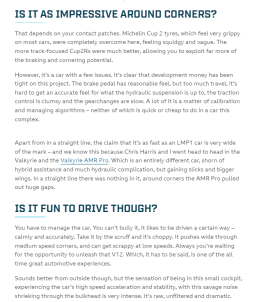If the Aston Martin handled like that in real life, every single motoring journalist that drove it would have been instantly killed.
There's zero grip at the rear on turn in, the tyres are immediately overwhelmed and you're a passenger.
How the team play tested this and thought 'that's good to go boss!' is beyond me.
From Top Gear:
That depends on your contact patches. Michelin Cup 2 tyres, which feel very grippy on most cars, were completely overcome here, feeling squidgy and vague. The more track-focused Cup2Rs were much better, allowing you to exploit far more of the braking and cornering potential.
However, it’s a car with a few issues. It’s clear that development money has been tight on this project. The brake pedal has reasonable feel, but too much travel, it’s hard to get an accurate feel for what the hydraulic suspension is up to, the traction control is clumsy and the gearchanges are slow. A lot of it is a matter of calibration and managing algorithms – neither of which is quick or cheap to do in a car this complex.
Apart from in a straight line, the claim that it’s as fast as an LMP1 car is very wide of the mark – and we know this because Chris Harris and I went head to head in the Valkyrie and the Valkyrie AMR Pro. Which is an entirely different car, shorn of hybrid assistance and much hydraulic complication, but gaining slicks and bigger wings. In a straight line there was nothing in it, around corners the AMR Pro pulled out huge gaps.
You have to manage the car. You can’t bully it, it likes to be driven a certain way – calmly and accurately. Take it by the scruff and it's choppy. It pushes wide through medium speed corners, and can get scrappy at low speeds. Always you’re waiting for the opportunity to unleash that V12. Which, it has to be said, is one of the all time great automotive experiences.
Sounds better from outside though, but the sensation of being in this small cockpit, experiencing the car’s high speed acceleration and stability, with this savage noise shrieking through the bulkhead is very intense. It’s raw, unfiltered and dramatic.
From EVO:
In slower corners it’s easy enough to decode what’s happening on the way in or the way out and react accordingly. You need to be especially mindful of how much torque you’re asking the rear tyres to transmit before the aero makes a meaningful difference, similarly how much braking force can be absorbed. In each instance there are electronic systems to rely on – you can feel the TC intervene, ESC is very hard to detect and ABS is really only there to stop a lightly loaded inside front wheel from grabbing in the final phase if you try and brake too hard and too deep into an apex.
It’s in higher speed corners a greater leap of faith is required because you don’t have the explicit, analogue reference points to draw from. It’s also clear the 20in front and 21in rear Michelin Cup 2’s (N-rated Porsche items) are working in a realm they are not entirely comfortable, so even if you do trust in the aero you still sense the tyre is struggling to cope. You certainly don’t get the utterly outrageous feeling of limitless grip that comes from the combination of slicks and wings.
From Autocar:
Pure lateral adhesion is one area where the Valkyrie doesn’t feel otherworldly, because of its need to wear road tyres. Our test car is riding on Michelin Pilot Sport Cup 2s rather than the more aggressive (but still street-legal) optional Cup 2 Rs. So while grip is huge, it is less than it would be in a track special riding on slicks. This feels most obvious in slower and tighter corners, where the Valkyrie turns keenly but the traction control works hard to maintain discipline on the way out. Increasing speed soon brings downforce and a corresponding sense of dynamic security. But the active suspension means that the Valkyrie never feels heavy or lacking in agility.
Nor does it feel snappy or scary, even when I turn the variable traction control down. This confirms that the transition from grip to slip, although sudden, is well flagged and easily corrected – certainly at relatively low speeds. Of course, this is on a bone-dry track with generous run-offs. A wet B-road would be a very different challenge. But the Valkyrie’s chassis seems impressively friendly considering the forces it has to contain and direct.





